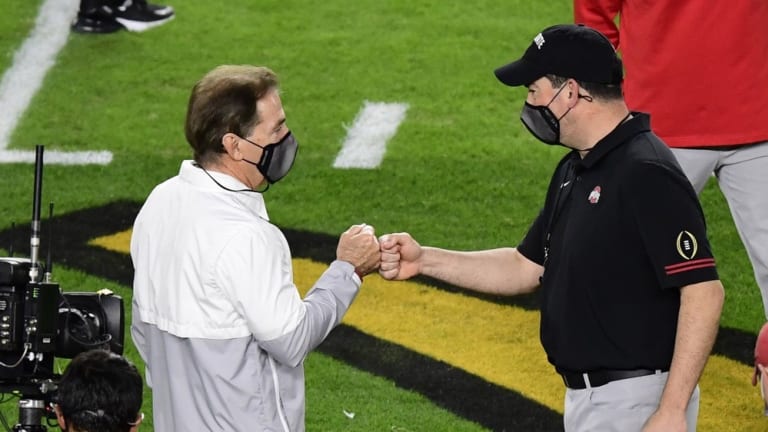
When It Comes to Recruiting, the Rich Stay Rich

In between bouts of shoveling snow and sipping hot tea, I’ve been thinking about football recruiting in general, and Big Ten recruiting in particular.
You may have seen these (not) breaking-news items that appeared recently:
- Ohio State topped the Big Ten in football recruiting.
- The sun rose in the East.
In what could easily be items 3 and 4, Alabama led the nation. And the SEC and its Soviet satellite, Clemson, dominated the top 10.
Here’s the national top 10, courtesy of 247sports.com. . . 1. Alabama. . . 2 Ohio State. . . 3 Georgia. . . 4 LSU. . . 5 Clemson. . . 6 Oregon. . . 7 Texas A&M. . . 8 USC. . . 9 Notre Dame. . . 10 Michigan.
Some thoughts:
1) Is it any wonder that the SEC dominates the national-championship scene?
2) Is it any surprise that after meeting for the national championship, Nick Saban and Ryan Day (shown above) also finished one-two in the competition for recruits?
Unlike pro sports, which use a drafting process to level the playing field, college sports are decidedly not level.
It just makes sense that young men who aspire to make big money as pro players will go to schools where they will have the best opportunity to realize that dream.
At the perennial powers, players have the best chance to showcase their skills. Those games are more closely watched, from important regular-season games to the post-season spotlight. They provide experience as well as exposure. And there’s no arguing with developmental coaching they receive at the elite programs.
I believe an eight-team playoff would help. Because it would allow more schools to dangle the playoff carrot on recruiting. But that would only add a few more schools to this rich-stay-rich system.
There’s no practical way to change that. Deal with it. Better yet, find the right coach and give him the right facilities—and you will give yourself a chance to be successful, up to a point.
Which brings me to the rankings in the Big Ten recruiting-battle, again courtesy of 247sports.com (with national ranking included). . . 1 Ohio State (2nd). . . 2 Michigan (10th). . . 3 Wisconsin (15th). . . 4 Maryland (19th). . . 5 Nebraska (20th). . . 6 Penn State (21st). . . 7 Iowa (23rd). . . 8 Minnesota (37th). . . 9 Rutgers (41st). . . 10 Michigan State (43rd). . . 11 Northwestern (49th). . . 12 Indiana (54th). . . 13 Purdue (73rd). . . 14 Illinois (74th).
A few thoughts. I have never been as fascinated by recruiting (or professional drafts, for that matter) as many people who follow sports. That’s partly because the teams I pay the most attention to are not especially good at recruiting. And partly because I believe in the wisdom imparted long ago by former Illini athletic director Ron Guenther when we asked him about rankings of recruiting classes.
``Ask me in a few years,’’ he would say. . . When they have played some games.
That said, I also believe in the wisdom imparted even longer ago by Damon Runyon: ``The race is not always to the swift nor the battle to the strong. But that's the way to bet.’’
With that in mind, a few thoughts about the Big Ten rankings. With one more disclaimer: One year of recruiting does not make a championship program, or a middling one.
Thanks to recruiting (and coaching and everything else), Ohio State looks like a lock to keep its stranglehold on the Big Ten.
There are programs that are capable of being regular challengers—notably Michigan, Penn State and Wisconsin.But even those schools would have to make major strides.
But they can still have successful program while striving for more. And so can the rest of the Big Ten.
I thought it was interesting that Maryland and Nebraska did well. The Cornhuskers are a traditional power—or used to be—that expects to compete for great things. Maryland is bolstered by its Big Ten status and a coach, Mike Locksley, who is a top-notch recruiter on familiar turf.
On the other end of the spectrum, Northwestern has defied the recruiting rankings for years, finishing higher in the standings than its recruiting would indicate. I wonder if Indiana, which has a coach, Tom Allen, who is showing a Pat-Fitzgerald-like ability to make the most of his talent, will also continue to defy the recruiting indicator.
Iowa, Minnesota and Rutgers (thanks to Greg Schiano) about where i would expect. I believe Michigan State has a chance to rise in the rankings as Mel Tucker re-establishes the Spartan program.
Purdue has failed to build on the early promise Jeff Brohm showed. Injuries and breaks have played a role in that. But weak recruiting is something that cannot continue if the Boilermakers are going to be competitive.
And then there’s Illinois. Another poor recruiting class was to be expected with the transition to a new coach. But we’ll see about Bret Bielema moving forward. He’s saying the right things, he has ties to Illinois highs schools and he has a grasp of what he wants to do.
If Bielema can be a hybrid who spots good fits that he can coach up (like Fitzgerald) and use the lure of Illinois’ tradition and proximity to Chicago to land some better players, the Illini could move up in the world.